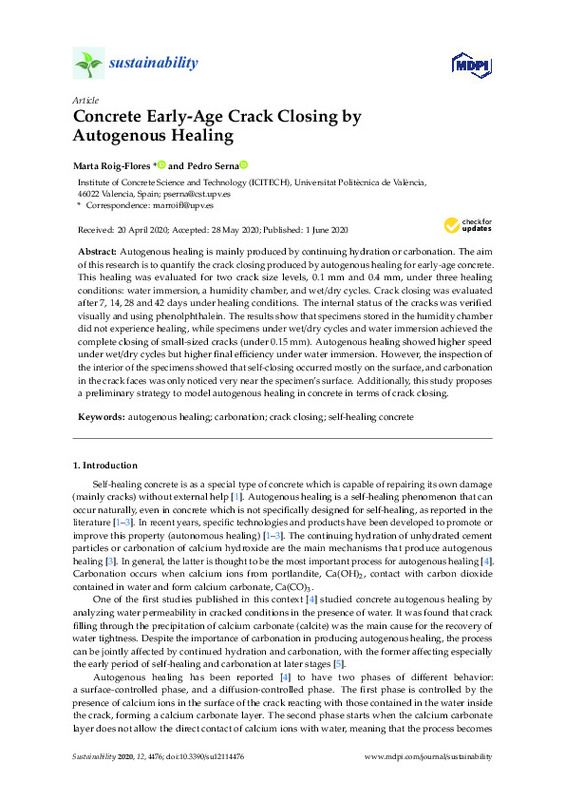De Belie, N., Gruyaert, E., Al-Tabbaa, A., Antonaci, P., Baera, C., Bajare, D., … Jonkers, H. M. (2018). A Review of Self-Healing Concrete for Damage Management of Structures. Advanced Materials Interfaces, 5(17), 1800074. doi:10.1002/admi.201800074
Van Tittelboom, K., & De Belie, N. (2013). Self-Healing in Cementitious Materials—A Review. Materials, 6(6), 2182-2217. doi:10.3390/ma6062182
Yuan, L., Chen, S., Wang, S., Huang, Y., Yang, Q., Liu, S., … Zhou, Z. (2019). Research on the Improvement of Concrete Autogenous Self-healing Based on the Regulation of Cement Particle Size Distribution (PSD). Materials, 12(17), 2818. doi:10.3390/ma12172818
[+]
De Belie, N., Gruyaert, E., Al-Tabbaa, A., Antonaci, P., Baera, C., Bajare, D., … Jonkers, H. M. (2018). A Review of Self-Healing Concrete for Damage Management of Structures. Advanced Materials Interfaces, 5(17), 1800074. doi:10.1002/admi.201800074
Van Tittelboom, K., & De Belie, N. (2013). Self-Healing in Cementitious Materials—A Review. Materials, 6(6), 2182-2217. doi:10.3390/ma6062182
Yuan, L., Chen, S., Wang, S., Huang, Y., Yang, Q., Liu, S., … Zhou, Z. (2019). Research on the Improvement of Concrete Autogenous Self-healing Based on the Regulation of Cement Particle Size Distribution (PSD). Materials, 12(17), 2818. doi:10.3390/ma12172818
Gagné, R., & Argouges, M. (2012). A study of the natural self-healing of mortars using air-flow measurements. Materials and Structures, 45(11), 1625-1638. doi:10.1617/s11527-012-9861-y
Suleiman, A. R., & Nehdi, M. L. (2018). Effect of environmental exposure on autogenous self-healing of cracked cement-based materials. Cement and Concrete Research, 111, 197-208. doi:10.1016/j.cemconres.2018.05.009
Qian, S., Zhou, J., de Rooij, M. R., Schlangen, E., Ye, G., & van Breugel, K. (2009). Self-healing behavior of strain hardening cementitious composites incorporating local waste materials. Cement and Concrete Composites, 31(9), 613-621. doi:10.1016/j.cemconcomp.2009.03.003
Yıldırım, G., Khiavi, A. H., Yeşilmen, S., & Şahmaran, M. (2018). Self-healing performance of aged cementitious composites. Cement and Concrete Composites, 87, 172-186. doi:10.1016/j.cemconcomp.2018.01.004
Rajczakowska, M., Habermehl-Cwirzen, K., Hedlund, H., & Cwirzen, A. (2019). The Effect of Exposure on the Autogenous Self-Healing of Ordinary Portland Cement Mortars. Materials, 12(23), 3926. doi:10.3390/ma12233926
Roig-Flores, M., Pirritano, F., Serna, P., & Ferrara, L. (2016). Effect of crystalline admixtures on the self-healing capability of early-age concrete studied by means of permeability and crack closing tests. Construction and Building Materials, 114, 447-457. doi:10.1016/j.conbuildmat.2016.03.196
Yang, Y., Lepech, M. D., Yang, E.-H., & Li, V. C. (2009). Autogenous healing of engineered cementitious composites under wet–dry cycles. Cement and Concrete Research, 39(5), 382-390. doi:10.1016/j.cemconres.2009.01.013
Yang, Y., Yang, E.-H., & Li, V. C. (2011). Autogenous healing of engineered cementitious composites at early age. Cement and Concrete Research, 41(2), 176-183. doi:10.1016/j.cemconres.2010.11.002
Liu, H., Huang, H., Wu, X., Peng, H., Li, Z., Hu, J., & Yu, Q. (2019). Effects of external multi-ions and wet-dry cycles in a marine environment on autogenous self-healing of cracks in cement paste. Cement and Concrete Research, 120, 198-206. doi:10.1016/j.cemconres.2019.03.014
Van Tittelboom, K., Gruyaert, E., Rahier, H., & De Belie, N. (2012). Influence of mix composition on the extent of autogenous crack healing by continued hydration or calcium carbonate formation. Construction and Building Materials, 37, 349-359. doi:10.1016/j.conbuildmat.2012.07.026
Huang, H., Ye, G., & Damidot, D. (2014). Effect of blast furnace slag on self-healing of microcracks in cementitious materials. Cement and Concrete Research, 60, 68-82. doi:10.1016/j.cemconres.2014.03.010
Wiktor, V., & Jonkers, H. M. (2011). Quantification of crack-healing in novel bacteria-based self-healing concrete. Cement and Concrete Composites, 33(7), 763-770. doi:10.1016/j.cemconcomp.2011.03.012
Snoeck, D., & De Belie, N. (2012). Mechanical and self-healing properties of cementitious composites reinforced with flax and cottonised flax, and compared with polyvinyl alcohol fibres. Biosystems Engineering, 111(4), 325-335. doi:10.1016/j.biosystemseng.2011.12.005
Ferrara, L., Van Mullem, T., Alonso, M. C., Antonaci, P., Borg, R. P., Cuenca, E., … De Belie, N. (2018). Experimental characterization of the self-healing capacity of cement based materials and its effects on the material performance: A state of the art report by COST Action SARCOS WG2. Construction and Building Materials, 167, 115-142. doi:10.1016/j.conbuildmat.2018.01.143
Zhong, W., & Yao, W. (2008). Influence of damage degree on self-healing of concrete. Construction and Building Materials, 22(6), 1137-1142. doi:10.1016/j.conbuildmat.2007.02.006
Sisomphon, K., Copuroglu, O., & Koenders, E. A. B. (2013). Effect of exposure conditions on self healing behavior of strain hardening cementitious composites incorporating various cementitious materials. Construction and Building Materials, 42, 217-224. doi:10.1016/j.conbuildmat.2013.01.012
Argiz, C., Menéndez, E., Moragues, A., & Sanjuán, M. Á. (2014). Recent Advances in Coal Bottom Ash Use as a New Common Portland Cement Constituent. Structural Engineering International, 24(4), 503-508. doi:10.2749/101686613x13768348400518
[-]









